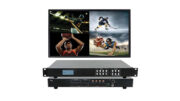Unless your cable is designed for a special purpose, you generally have a choice of two colors: white and black. It seems for years that black cable was really the only choice but sometime in the 1990s white cable crept in, possibly to blend better with white walls when installers didn’t take the time to properly fish cables.
Is that why cable and satellite installers use white cables?
Yes I tend to believe so. Satellite installers especially came under fire in the 2000s. Unlike cable TV, satellite almost always required that new cables be run, often two or three into the same location. Cable TV systems use a much stronger signal than satellite and as a result they are more tolerant of old, low quality cables. Satellite installers have always been told to run new cables whenever they enter the premises. Using white cables probably made it easier for homeowners who just weren’t having any of it.
Today satellite TV providers run only one cable to each receiver. Installers still tend to avoid existing in-wall cables. Old cables can still cause all sorts of problems. Finding those problems requires expensive equipment that average installers don’t have on their trucks.
Solid Signal works with Perfect Vision and Belden, the largest cable manufacturers in the country, who tell us that the demand for white cable is still very strong.
Which color should you choose?
You have your choice of white or black when you shop for cables at Solid Signal, but which should you choose? That really depends on you. In most cases, it makes no difference at all. It’s just your choice of what looks better in your installation. If you live in an area where there is a lot of strong sunlight, white cables may weather a little better in the long run, as black cables absorb a bit more heat. Unless you’re in the desert, though, it’s going to take years before those cables oxidize to the point where it’s a problem.
It’s worth mentioning something else. Aside from black and white, we also carry orange cables. Orange cables indicate use for burial or other special purposes. There are other colors of cables available for special order. If you’re wiring a large building they might be worth it. In fact there was a push about a decade ago to standardize the colors of satellite cables and sell cables already banded together in packs of 7 with different colors. This probably would have made installation easier but the extra cost wasn’t worth it.
We’ve found that most customers will avoid the extra cost of these cables and just label them properly or use a cable toner to locate cables quickly and easily.
Just, whatever you do, don’t paint the cable.
It’s common for DIYers to paint over cables in an attempt to hide them. While it’s true that this doesn’t automatically create bad cables, it can be a problem. Solvents within the paint itself could potentially eat through the rubber outer sheath or make it brittle. If you are tired of looking at cables outside your wall, the best option is to fish them through the walls. Solid Signal sells several tools for this purpose. If you’re not confident of your abilities, you may want to hire a pro here, as it makes more sense than destroying your walls.





